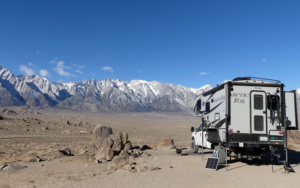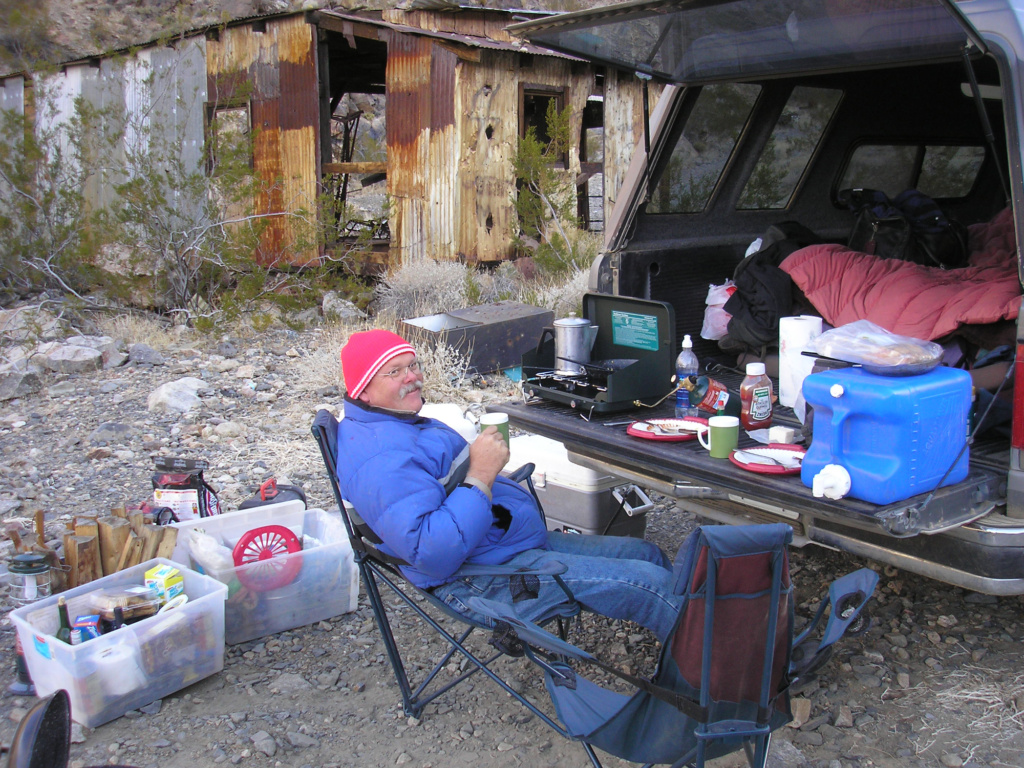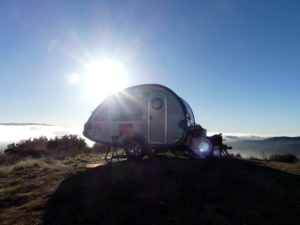Condensing recreational camping into 5 descriptive classes for a better definition of your favorite ways to camp. How to define boondocking and dispersed camping.
Camping is a word that evokes the smell of a campfire while eating smores and playing like a wild child with mother nature. Types of camping can be anything from backpacking in the remote wilderness to sleeping in a luxurious RV in a park that resembles a small city. So what makes camping so diverse and hard to define? Is boondocking better than other forms of camping?
Camping is as old as time, creating a very broad term to define. Our defintion drills down to describe the many recreational ways people PREFER to camp.
Cultural historian Phoebe Young spent 20 years delving into 2 key questions: What does it mean to camp, and why does it matter? Her book, Camping Grounds: Public Nature in American Life from the Civil War to the Occupy Movement, portrays the history of this U.S. pastime and how its definition has shifted.
Here we limit our scope to traditional recreational camping.
Necessity is the mother of invention
Finding an affordable way to enjoy a romantic getaway after Pres unexpectedly lost his job, was a challenge. I cleaned out the back of our pickup truck sheltered by a camper shell and loaded it with an air mattress, quilt and pillows, BBQ and food to make a nice dinner.
We drove an hour to a beautiful overlook of the Pacific Ocean where we ate dinner off of the tailgate and slept to the sound of crashing waves.
That little campout in the later 1990s was the beginning of camping in the back of our truck for many memorable adventures. We loved that humble trip as much or more than if we’d had the money to stay in a luxury hotel along the coastline.
Dispersed or Boondock camping
Most of our camping is DISPERSED camping. Other terms also used are boondocking, dry camping, overlanding or wild camping. Dispersed camping folks typically enjoy the solitude and primitive experience of wilderness camping away from crowded campgrounds. This type of camping is often found in National Forests or National Parks outside of developed campgrounds.
Where can you find places to camp? Check out our comprehensive post for our proven best tips for how to research where to find great campsites.
Driving rough roads using four-wheel drive takes us to remote, quiet campsites
The onset of Covid 19 and the closing of campgrounds across the country caused a boom to RV, camping van and truck camper sales. Manufacturers are still catching up to their backlog of orders. Boondocking offered a way to escape the confines of quarantine indoors to enjoy fresh air and sunshine while safely remaining self-contained.
Sadly, many pristine areas suffered abuse from the flood of increased visitors and uncaring campers causing areas beloved for years to be closed off. Boondock with care to leave your campsite even cleaner than you found it to preserve this awesome privilege for generations to come.
Resources to learn boondocking
Whether you’re a camping vet or a newbie, camping is a constant learning process. Online, I have found several good resources for how to enjoy dispersed camping:
- How to Boondock – The Ultimate Guide by Free Roam
- Boondocking 101 by Campendium
- Boondocking tips by Truck Camper Adventures
- Off-road truck camping by Truck Camper Magazine
- Boondocking how-to series by Boondocking Bible
A reformed snob’s definition of camping
Staying in a “developed” campground has never been my preference for camping, though we have occasionally needed to do that. While young and physically fit I confess to being a camping snob. To call sleeping in a luxury RV “camping”, seemed an insult to those of us carrying our food, sleeping bag, and tiny tent on our backs in the rugged wilderness of the Sierras.
Most of my years of dispersed camping have been the “tailgate” style. I define this as sleeping in the bed of our 4×4 pickup truck after a full day of driving desert back roads to discover abandoned mines, ghost towns, or isolated cabins. Meals were served on the tailgate where our cookstove, lantern, and water jug sat.
More than 40 years of wilderness camping have honed me into less of a snob, humbled by time. We are now empty nesters with some physical challenges, thus making the welcome change of “glamping” in an Arctic Fox mounted on a flatbed F-350 1-ton truck. I’d rather cook and sleep in our cozy camper while traveling than in noisy motels off the highway.
We love to spend our evenings under the stars with a small campfire glowing while enjoying a good cigar with a glass of whiskey to warm the soul. In a wilderness setting, we enjoy the contented peace of the wind in the trees whispering our Creator’s presence.
Now THAT is how we define camping.
How a simple notebook can make ANY definition of camping sooo much easier
Can you find the menu and campsite notes you used from your last trip in the next 5 minutes?
Has Dad rustled up his famous banana pancakes only to discover you forgot to bring any maple syrup? Ketchup anyone?
A special notebook solves these problems keeping all my recipes, menu and lists organized and easy to find. A simple 3-ring binder can transform camping chaos into organized bliss where you have all your info at your fingertips. Read how to make your own notebook with our easy step-by-step instructions.
Camping signs
The idea of dividing camping into classes came to me while passing numerous “camping” signs along the highway – usually for an RV Park or KOA. Sadly in California, there has been an increase of NO camping signs along our scenic highways due to abuse by the surge of people littering and toileting where we used to enjoy pristine beauty. Locals often cannot find “spur of the moment” campsites as reservations must be made 6 to 12 months in advance.
Campgrounds also could be broken down into their own section of classes from Primitive to Full Hook-ups. There are many online resources that cater to campground campers which are beyond our scope here.
“Classes” to better define types of camping:
Breaking camping down into 5 main classes will better serve campers as to the difficulty and type. Rock climbs and 4×4 roads have classes to describe the difficulty of the climb or drive. These classes are usually ranked 1 to 5, with 5 being the most difficult.
Since the initial creation of our list we’ve noticed more sources are now posting ways to categorize types of camping. Perhaps one day it will be “standardized.”
Note that nearly all of these classes can be enjoyed as dispersed camping. Class 5 is the most “difficult” rank.
Class 5 – Backpacking:
Carrying all of your vital necessities by backpack on foot, by bicycle, kayak or canoe into the wilderness where there is no TV, internet, or “camp” store to buy what you forgot to pack. This is the “Navy Seals” version of camping.
Any amenities you have must be packed into the backcountry.
Class 4.5 – Packing in by horse, mule, kayak or mountain bike:
A variation of backpacking where you ride in by horse or mountain bike or have your camping gear packed in by mules. or lamas. Lamas and pack animals have the right of way on hiking trails.
Boaters can launch at a lake packing in their gear to camp in places unreachable by vehicle.
Class 4 – Tent camping:
Tents can vary in size from a 1 man to multi-room family size. These vary from canvas with poles to instant pop-ups. All usually require sleeping bags, cooking on a camp stove or BBQ, and hauling your food and beer in an ice chest.
Tent campers enjoy the flexibility of staying in both developed campgrounds or in the rugged wilderness where vehicles are not allowed.
Class 3: – Truck or tent trailer camping:
Sleeping in the back of your pickup truck, Jeep or SUV with or without a camper shell. Or, pulling a glorified tent on wheels with screened windows and a small kitchen.
This method usually requires some type of maintained road to access your campsite.
Class 2 – Truck camper, van, or travel trailer camping:

Glamping in our truck camper
Camping in a camper mounted on a truck, van camper, or small travel trailer (think R pod or T@B). A camper or trailer affords a place to eat “indoors” free of bugs and wind, a cookstove, and perhaps a porta-potty with either an inside or outside shower.
Sportsmobile vans and Earth Roamers are the top of the line in this category and can crossover into the RV category.
Class 1 – RV or cabin camping:
Where you drag your 2nd home along with you which includes all the amenities of a luxury hotel suite. You get to clean and keep house just like at home. (No offense to those that do, just my “camp snob” sense of humor.) RVs have their own set of classes and include everything from a Mini Winnie to a 40′ bus.
Don’t forget a 60′ yacht can be used to camp! Who says you can only camp on land?
I loved summer camp as a kid…
Sleeping in a cabin full of gabby girls in our bunk beds and sharing flashlight adventures to the bathrooms after dark + mosquito bites and poison oak + chowing down meals in a dining hall and horseback riding lessons = Ahhh, the carefree joys of playing flashlight tag and later singing silly songs around a campfire for lifetime memories.
I’ve had the privilege of camping in every class 1 through 5. My parents enjoyed a 30-foot RV, so I did get to experience Class 1 when they took their grandchildren to Yosemite or the Pacific coast. I have yet to sail on a yacht, however.
Let me know if I missed a style of camping that should be included in a “class.” Don’t you think implementing classes for camping would provide clarity and bragging rights? Why should the 4 wheelers and rock climbers get all the glory?



I like your scale of camping. I see what you mean about crowded civilized campsites. I have been to a couple of state parks that were a hot spot for people who want to get out of town and party in the wilderness. I have witnessed some wild and crazy parties at state park campsites and often wonder why the heck people would travel all the way to the woods just to get wasted. How do you find secluded campsites that you can also bring your car to?
Yes, I too have wondered why folks want to have loud parties in the quiet pristine wilderness. “Different strokes” as they say. 😉
Plenty of folks go car camping in dispersed areas too. You just can’t get off-road the way a 4×4 can. You will need to be extra careful due to low clearance, loose soil, etc. but trust me, my hubby and I went plenty of places on back roads via our Chevy Nova or 2 wheel drive pickup truck. Be sure to carry a “regular” (better than a donut type) spare tire as flats are common in the back country.
I have researched and put together a resource list of apps, maps and links you can use to find dispersed camping using your car. Simply subscribe to my newsletter and it is my welcome gift to you. 😉 You will find a link on my home page. I hope you will check it out.
Interesting idea to classify camping. In Canada we can’t car camp (dispersed camping) in national parks. We can back pack to designated backcountry sites or reserve spots in the campgrounds. I think driving and camping along some back road on crown land would be a fun little adventure I’d enjoy doing some day!
Camping in Canada is definitely on my bucket list! Thanks for the heads up regarding dispersed camping Canadian style. I have only been in Montreal and Quebec City as a teen and I look forward to going back as well as exploring the rest of your beautiful country.
I love to bicycle cam, both via mountain bike on trails and gravel roads and touring bike. I also really enjoy kayak camping. All of these require using your own muscles to carry your camping supplies and propel yourself so I would rank them somewhere between horse camping and backpacking.
Yes, I so agree! Using your own muscles to pack in your camping gear is the toughest and most rewarding form of camping. I no longer enjoy having those muscles and rely on truck camper style “glamping” now. Thanks for adding bicycling and kayaking as a means of getting into the backcountry to camp. 😉